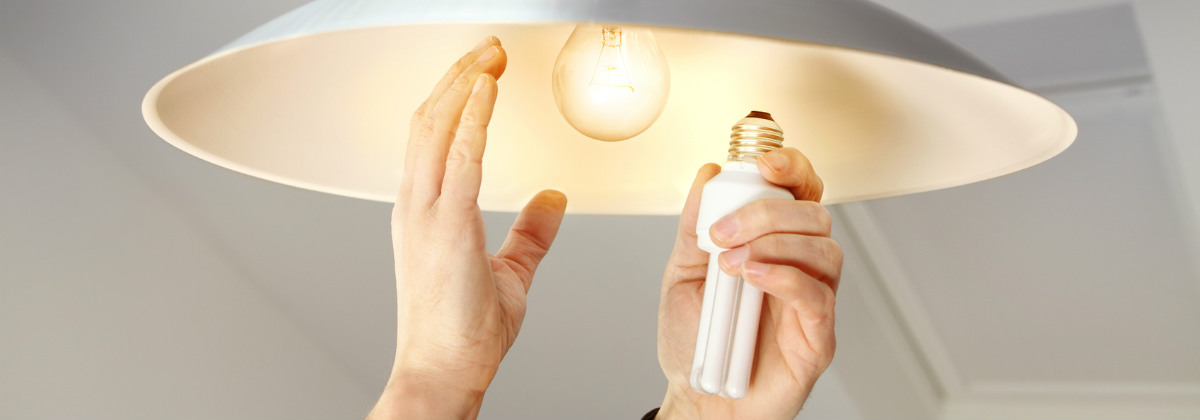It’s easy to overlook how much your lights cost to run. After all, it can’t be that much, right? Well, that depends on the types of bulbs you have installed. Here we take a look at the common types of residential light bulbs and see just how much they’re adding to your electricity bills.
On this page:
What are the different types of light bulbs?
There are several types of lights bulbs suitable for different applications, be it outdoor, downlight, lamps or ceiling. Focusing for the moment on interior ceiling lights, there are four types of light bulbs that you might find around a typical household – incandescent light bulbs, halogen light bulbs, compact fluorescent lights (CFLs) and light emitting diodes (LEDs).
- Incandescent bulbs: These light bulbs are simple and cheap, but very inefficient to run. Incandescent bulbs have been progressively phased out since 2009 in Australia, though you might still find some in very old properties.
- Halogen: These bulbs were considered a great substitute for incandescent lights, with many bulbs coming in a similar shape and size. The halogen light is also notably more efficient than an incandescent bulb. Halogen lights, however, have also slowly been phased out of use since September 2021 in Australia, due to the rise of more energy efficient options.
- CFLs: These are those white spiralled bulbs, and are often considered to be the first truly efficient commercial lighting solution. These are still prevalent in many households.
- LEDs: These have blown up in popularity recently. While LED bulbs are more expensive to purchase, they’re generally the most efficient bulb, requiring little electricity to produce just as much light as other bulbs.
What are the hourly costs of using each type of light?
The average hourly cost of using a light bulb can sit anywhere from 0.2c to 3.2c, depending on the type of light bulb used and the electricity usage rate charged on the household’s power bill, according to Canstar Blue data.
Below, we’ve broken this data out by capital city and light bulb type to help households determine what their home lighting may be costing them by the hour. Please note, this information should be treated as a guide only, and accounts for a single light bulb’s use. Actual running costs may be significantly higher depending on the number of bulbs in a households.
Hourly estimated electricity costs for each light bulb type, per capital city
← Mobile/tablet users, scroll sideways to view full table →
| Capital City | Halogen | CFL | LED |
|---|---|---|---|
| Canberra | 1.8c | 0.4c | 0.2c |
| Melbourne | 1.8c | 0.4c | 0.2c |
| Darwin | 2.0c | 0.4c | 0.2c |
| Hobart | 2.1c | 0.4c | 0.2c |
| Perth | 2.2c | 0.4c | 0.2c |
| Brisbane | 2.2c | 0.4c | 0.2c |
| Sydney | 2.5c | 0.5c | 0.3c |
| Adelaide | 3.2c | 0.6c | 0.4c |
Source: www.canstarblue.com.au – 14/09/2023. Electricity usage cost estimates based on average electricity usage rates: 35.5c/kWh in Sydney, 26.3c/kWh in Melbourne, 31.3c/kWh in Brisbane, 45.3c/kWh in Adelaide, 30.8c/kWh in Perth, 29.5c/kWh in Hobart, 28.1c/kWh in Darwin and 26.2c/kWh in Canberra. Light bulb electricity usage (70W for Halogen, 14W for CFL, 8W for LED) and operating life averaged over a sample of sources.
Paying too much on your power bill? See if you could be saving with one of the cheap electricity plans
Here are some of the cheapest published deals from the retailers on our database that include a link to the retailer’s website for further details. These are products from referral partners†. These costs are based on the Ausgrid network in Sydney but prices may vary depending on your circumstances. This comparison assumes general energy usage of 3900kWh/year for a residential customer on a single rate tariff. Please use our comparison tool for a specific comparison in your area. Our database may not cover all deals in your area. As always, check all details of any plan directly with the retailer before making a purchase decision.
Here are some of the cheapest published deals from the retailers on our database that include a link to the retailer’s website for further details. These are products from referral partners†. These costs are based on the Citipower network in Melbourne but prices may vary depending on your circumstances. This comparison assumes general energy usage of 4000kWh/year for a residential customer on a single rate tariff. Please use our comparison tool for a specific comparison in your area. Our database may not cover all deals in your area. As always, check all details of any plan directly with the retailer before making a purchase decision.
Here are some of the cheapest published deals from the retailers on our database that include a link to the retailer’s website for further details. These are products from referral partners†. These costs are based on the Energex network in Brisbane but prices may vary depending on your circumstances. This comparison assumes general energy usage of 4600kWh/year for a residential customer on a single rate tariff. Please use our comparison tool for a specific comparison in your area. Our database may not cover all deals in your area. As always, check all details of any plan directly with the retailer before making a purchase decision.
Here are some of the cheapest published deals from the retailers on our database that include a link to the retailer’s website for further details. These are products from referral partners†. These costs are based on the SA Power network in Adelaide but prices may vary depending on your circumstances. This comparison assumes general energy usage of 4000kWh/year for a residential customer on a single rate tariff. Please use our comparison tool for a specific comparison in your area. Our database may not cover all deals in your area. As always, check all details of any plan directly with the retailer before making a purchase decision.
Which type of light bulb is the cheapest to use?
According to Canstar Blue’s calculations, LEDs are consistently the cheapest light bulb to use in the home, only adding as much as $3.62 to power bills when operating over a 1,000 hour period. CFLs came in at a close second, costing as much as $6.34 over the same period. Halogens were found to cost considerably more than both options however, with as much as $31.71 being added to power bills for each globe used over 1,000 hours.
Again, we’ve broken this data out by capital city and light bulb type below. Please note, these calculations refer to only one light bulb’s use for 1,000 hours.
Estimated electricity costs for each light bulb type at 1,000 hours use, per capital city
← Mobile/tablet users, scroll sideways to view full table →
| Capital City | Halogen | CFL | LED |
|---|---|---|---|
| Canberra | $18.34 | $3.67 | $2.10 |
| Melbourne | $18.41 | $3.68 | $2.10 |
| Darwin | $19.68 | $3.94 | $2.25 |
| Hobart | $20.65 | $4.13 | $2.36 |
| Perth | $21.57 | $4.31 | $2.46 |
| Brisbane | $21.77 | $4.35 | $2.49 |
| Sydney | $24.85 | $4.97 | $2.84 |
| Adelaide | $31.71 | $6.34 | $3.62 |
Source: www.canstarblue.com.au – 14/09/2023. Electricity usage cost estimates based on average electricity usage rates: 35.5c/kWh in Sydney, 26.3c/kWh in Melbourne, 31.3c/kWh in Brisbane, 45.3c/kWh in Adelaide, 30.8c/kWh in Perth, 29.5c/kWh in Hobart, 28.1c/kWh in Darwin and 26.2c/kWh in Canberra. Light bulb electricity usage (70W for Halogen, 14W for CFL, 8W for LED) and operating life averaged over a sample of sources.
Lighting can account for as much as 10% of the average household electricity budget, according to the government’s energy.gov website, so understanding how much power your lightbulbs are chewing through may help you to reduce some of those pesky costs. While our data found that LEDs were typically the most cost efficient option, it may not be viable for your household to switch all your lights over to this type with the drop of a hat. In this case, you may find some quick wins in monitoring your usage, utilising any smart controls you may already have in place or switching to a power plan with cheaper usage rates instead.





Share this article